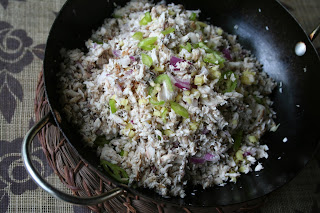

- 1/2 kilo finely ground pork
- 2 t finely chopped or grated ginger
- 2 t sugar
- 1/4 c chopped pork fat (optional)
- 1/4 c finely chopped singkamas (jicama)
- 1/4 c finely chopped carrots
- 2 T finely chopped scallions
- 1 egg
- 3-4 T soy sauce
- 1 T sesame oil
- 1 T cornstarch
- 1 pack large size wonton wrappers (molo wrappers)
- Oil for frying
Simply prep all ingredients and mix them well in a bowl. Fill the middle of the wonton wrapper with 1 t of the meat mixture and gather up the sides to wrap around the filling. Try to keep the corners upright so it will "bloom" when deep fried. The difficulty with wonton wrappers is they get easily wet or damp, and stick to the tray or plate, causing it to rip. The trick is to line the tray with a cloth or tea towel.
Heat oil through, but make sure it is not smoking or else you will end up with cooked wrappers but raw meat. Without the benefit of an oil thermometer, I got this easy to follow tip: Dip a barbecue stick in the oil, and when the bubbles run up the stick, it is ready.
Gently drop about 4-5 pieces at a time. Too many pieces will cause the temperature of the oil to drop, resulting in greasy dumplings. What you want are golden brown and crispy bites.
To remove excess oil, place newly fried wontons on kitchen paper towels. Sweet chili sauce is the perfect dip for these crunchy morsels. Just dip and pop them into your mouth. We eat it with yang chow- chinese style fried rice or as my parents would call it "morosquieta". With a side bowl of egg-drop soup or noodle soup.







































